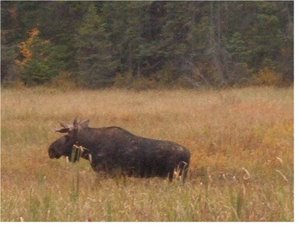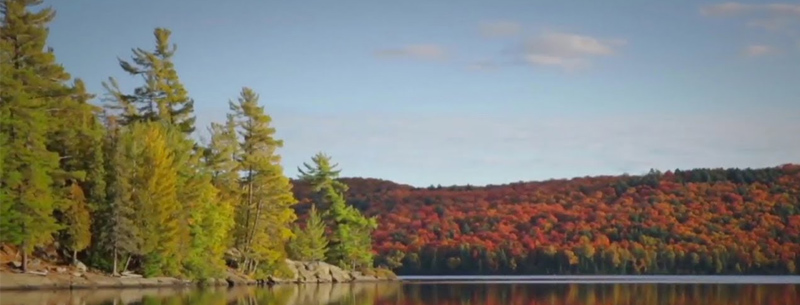Algonquin Park is the most famous park in Ontario. Long associated with the Group of Seven artists, Algonquin offers today’s artists and nature lovers a wealth of features, such as Wildlife, Attractions, and a variety of Accommodations.
Algonquin holds a special place in the heart of many visitors. For each of us, it has a different meaning.

For those of us who camped there as children, Algonquin brings back memories of chilly swims in clear lakes, the thrill of paddling our first canoe, the scent and crunch of pine needles on a forest floor, our first sight of the majestic moose, the crackling sound of campfires, the eerie, mournful calls of the loon and the howls of the wolfpack.
Art lovers know it as the inspiration for many of the works of the Group of Seven and the mystery-shrouded painter Tom Thomson, as well as countless other artists past and present, professional and amateur.
For couples, the Algonquin experience is all about the romance of the woods, the isolation of the setting, and the coziness of that cabin for two.
Wildlife-lovers fondly recall their thrilling encounters with all kinds of animals seen up close.
Foreign visitors visit the park in busloads every year, especially in early September to see the Fall Colours. It’s an iconic Canadian experience.
Biggest and oldest of Ontario parks
Algonquin is the province’s oldest provincial park (established in 1893), and is often called Ontario’s “crown jewel”. As gems go, this one is a whopper. It’s the largest park in Ontario. If you’re measuring in size alone, this park is sure to impress:
- 2,000 km of canoe routes
- 7,725 square kilometers in size (or 3,000 square miles)
- 55 km across on Hwy 60, the southern road that most day-trippers traverse.
But size isn’t everything — it’s what’s inside that counts. And what’s inside is a pine forest, rivers, lakes, rock, and, most important to many, wildlife … In fact, Algonquin Park was originally established to protect the wildlife within.
Wildlife in Algonquin Park
Here are some wild animals you might see on your visit:
- Wolves
- Black bears
- Deer
- 250 bird species
- Fish and turtles
- Moose – here’s the one we saw on our last trip:

He was just sloshing along through a marshy field not far from the highway. I jumped out of the car to take this picture!
Other attractions in Algonquin Park
Algonquin Park, though beautiful, is not a pristine place. Humanity has invaded to a degree. In some parts, there is even logging going on. “Controlled logging” – but logging nonetheless. The loggers were there even before the tourist trade arrived. Visitors are unlikely to see evidence of it, as it’s further north than most of us venture.
Some of the human interventions will be appreciated by many visitors, though. For example:
Algonquin Art Centre
At km 20, on a small hill next to Found Lake. Features “wilderness and wildlife talent” such as Robert Bateman, the internationally-famous wildlife artist. Meet-the-artist programs and workshops for adults and children. Open from about June to Oct. Visit www.algonquinartcentre.com
Art in the Park
For art lovers, Algonquin Park is forever paired in the mind with the Group of Seven, who loved this place. Are you a budding Tom Thomson or Robert Bateman? Or do you want to capture memories of nature with your camera? You can take workshops with experienced artists in the park.
Algonquin Logging Museum
It’s just inside the East Gate, at km 54.5, and features a video about the history of logging in the park, displays, and a bookstore.
Algonquin Visitor Centre
At km 43, this modern visitor center features displays about the geography and plants and animals of the area. It frequently has displays of paintings or photos of the park done by artists. There’s also a cafeteria with a nice view. The great deck out back has a view of typical Algonquin scenery. Here’s a photo I took while standing on the deck:
Interpretive Programs
The Park organization offers guided walks, canoe outings, and public wolf howls (no, I’m not making that last one up!). These run during July and August and weekends in the fall (check their site for details). http://www.algonquinpark.on.ca/index.html
Walking and Hiking Trails
We tend to think of them as part of nature but they’re made and maintained by humans too. You can pick up trail guides at the entry points to the park. All kinds of different trails – for walking, backpacking (and camping), skiing, snowshoeing, mountain biking, even dog sledding! Be warned though: some of these trails look easy but can be very hilly!
Here’s a gorgeous video shot by the Friends of Algonquin Park. It shows more of the scenery and wildlife and other attractions you’ll find in the park. Click on the arrow to start the show:
Directions to Algonquin Park
The park is about 3 hours north of Toronto by car. The two main entrances are the West and East Gates. The West gate is near the town of Dwight. The East gate is near the town of Whitney.
Highway 60, the Parkway Corridor, runs through Algonquin Park from west to east, along its southern region. This road is numbered in kilometers, with “0” at the west gate and 55 at the east gate. Along Highway 60 you’ll find some of the park’s main tourist attractions like the Visitor Centre, the Algonquin Art Centre, The Portage Store (at the famous Canoe Lake where Tom Thomson drowned), some resorts and lodges, etc. (see Attractions and Accommodations). You can rent canoes, kayaks, and mountain bikes by the day through “outfitters” – companies that sell and rent wilderness exploration gear to travelers.
If you want to go further into the interior of the park, these professional outfitters can supply you with the equipment and food you’ll need for wilderness camping as well.
Fees: There’s a small fee per car (around $11) to enter the park. The fee covers maintenance of the park, staffing, access to facilities, trails, etc.
Accommodation in the Park
For some travelers, the only way to stay in the park is to camp out. There are many opportunities to do this, both in campgrounds and in the wild. Campgrounds with electricity run around $30-40 a night per car, and interior camping (in the wild) is about $10/person/night. You can also rent a yurt for about $80 a night! The camping fee includes the daily use fee. Check current prices on the official Algonquin Park web site at http://www.algonquinpark.on.ca/index.html.
For those needing a little more comfort, there are three lodges in the park:
- Arowhon Pines
- Bartlett Lodge
- Killarney Lodge
You can also rent a historic Park Ranger Cabin from $54 to $124 a night.
In the area surrounding the park, there are dozens of resorts, hotels, and motels.
For the budget-minded, the Algonquin Backpackers Hostel offers an inexpensive way to visit Algonquin Park. This hostel is about 30 km (half-an-hour drive) from Algonquin Park in the tiny town of Maynooth. It compares favorably to other hostels that I’ve stayed in both in Canada and Europe. I liked the homey atmosphere — pictures on walls, good reading, and tv room, fully equipped (though small) kitchen. We had a double private room with 2 single beds. We had to share the washrooms and showers down the hall, but it wasn’t that busy. The price was good when you compare it with cheap motels/hotels in the area that go for approximately double the cost for a room with no kitchen facilities. Maynooth is very small and closes up at night except for the gas station and liquor stores, but Bancroft is only about 1/2 hour drive south and it has a grocery store, restaurants, and stores.
For more information, check the park’s official web site: Algonquin Park
